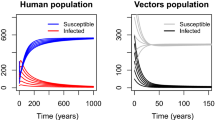Abstract
We propose and study a vector-borne disease model with direct transmission and age-structured differential susceptibility in the host population. Employing the approach of Lyapunov functionals, we establish a threshold dynamics completely characterized by the basic reproduction number, \({\mathcal {R}}_0\), that is, the disease-free equilibrium is globally asymptotically stable when \({\mathcal {R}}_0<1\) while the endemic equilibrium is globally asymptotically stable when \({\mathcal {R}}_0>1\).
Similar content being viewed by others
References
Browne, C.J., Pilyugin, S.S.: Global analysis of age-structuredwithin-host virusmodel. Discrete Cont. Dyn. Syst. Ser. B 18, 1999–2017 (2013)
Dang, Y., Qiu, Z., Li, X.: Competitive exclusion in an infection-age structured vector-host epidemic model. Math. Biosci. Eng. 14, 901–931 (2017)
Foy, B.D., Kobylinski, K.C., Foy, J.L.C., et al.: Probable non-vector-borne transmission of Zika virus, Colorado, USA. Emerg. Infect. Dis. 17, 880–882 (2011)
Gourley, S. A., Liu, R., Wu, J.: Some vector borne diseases with structured host populations: extinction and spatial spread, SIAM J. Appl. Math. 67, 408-433 (2006/07)
Gulbudak, H., Cannataro, V.L., Tuncer, N., Martcheva, M.: Vector-Borne pathogen and host evolution in a structured immuno-epidemiological system. Bull. Math. Biol. 79, 325–355 (2017)
Hale, J.K.: Asymptotic behavior of dissipative system. AMS, Providence (1998)
Iannelli, M.: Mathematical Theory of Age-Structured Population Dynamics. Comitato Nazionale per le Scienze Matematiche, Consiglio Nazionale delle Ricerche (CNR), Giardini, Pisa (1995)
MacDonald, G.: The analysis of equilibrium in malaria. Trop. Dis. Bull. 49, 818–828 (1952)
Lashari, A.A., Zaman, G.: Global dynamics of vector-borne diseases with horizontal transmission in host population. Comput. Math. Appl. 61, 745–754 (2011)
Lashari, A.A., Zaman, G.: Optimal control of a vector borne disease with horizontal transmission. Nonlinear Anal. Real World Appl. 13, 203–212 (2012)
Li, X.-Z., Yang, J., Martcheva, M.: Age Structured Epidemic Modeling, Springer Interdisciplinary Applied Mathematics 52. Springer, New York (2020)
Magal, P., Zhao, X.-Q.: Global attractors and steady states for uniformly persistent dynamical systems. SIAM J. Math. Anal. 37, 251–275 (2005)
Malaria at https://www.who.int/news-room/fact-sheets/detail/malaria
Nadim, S.S., Ghosh, I., Chattopadhyay, J.: Global dynamics of a vector-borne disease model with two transmission routes. Internat. J. Bifur. Chaos Appl. Sci. Engrg. 30(6), 2050083, 23 (2020)
Ouaro, S., Traoré, A.: On the global dynamics of a vector-borne disease model with age of vaccination, Int. J. Differ. Equ., Art. ID 4168061, 11 pp (2018)
Ross, R.: The Prevention of Malaria, 2nd edn. Murray, London (1911)
Smith, H.L., Thieme, H.R.: Dynamical Systems and Population Persistence. American Mathematical Society, Providence, RI (2011)
Tuncer, N., Giri, S.: Dynamics of a vector-borne model with direct transmission and age of infection, Math. Model. Nat. Phenom., 16, Paper No. 28, 25 pp (2021)
Wang, S., Nie, L.-F.: Global dynamics for a vector-borne disease model with class-age-dependent vaccination, latency and general incidence rate, Qual. Theory Dyn. Syst. 19, no. 2, Paper No. 72, 34 pp (2020)
Wang, X., Chen, Y.: An age-structured vector-borne disease model with horizontal transmission in the host. Math. Biosci. Eng. 15, 1099–1117 (2018)
Wang, X., Chen, Y., Liu, S.: Global dynamics of a vector-borne disease model with infection ages and general incidence rates. Comp. Appl. Math. 37, 4055–4080 (2018)
Wang, X., Chen, Y., Martcheva, M., Rong, L.: Asymptotic analysis of a vector-borne disease model with the age of infection. J. Biol. Dyn. 14, 332–367 (2020)
Wei, H.-M., Li, X.-Z., Martcheva, M.: An epidemic model of a vector-borne disease with direct transmission and time delay. J. Math. Anal. Appl. 342, 895–908 (2008)
Yosida, K.: Functional Analysis, 2nd edn. Spring, Berlin-Heidelberg (1968)
Author information
Authors and Affiliations
Corresponding author
Additional information
Publisher's Note
Springer Nature remains neutral with regard to jurisdictional claims in published maps and institutional affiliations.
Research is supported partially by the National Natural Science Foundation of China (No. 11871415), the Henan Province Distinguished Professor program, and the Natural Sciences and Engineering Research Council of Canada (NSERC)
Rights and permissions
About this article
Cite this article
Li, X., Zou, X., Cai, L. et al. Global dynamics of a vector-borne disease model with direct transmission and differential susceptibility. J. Appl. Math. Comput. 69, 381–402 (2023). https://doi.org/10.1007/s12190-022-01745-8
Received:
Revised:
Accepted:
Published:
Issue Date:
DOI: https://doi.org/10.1007/s12190-022-01745-8




